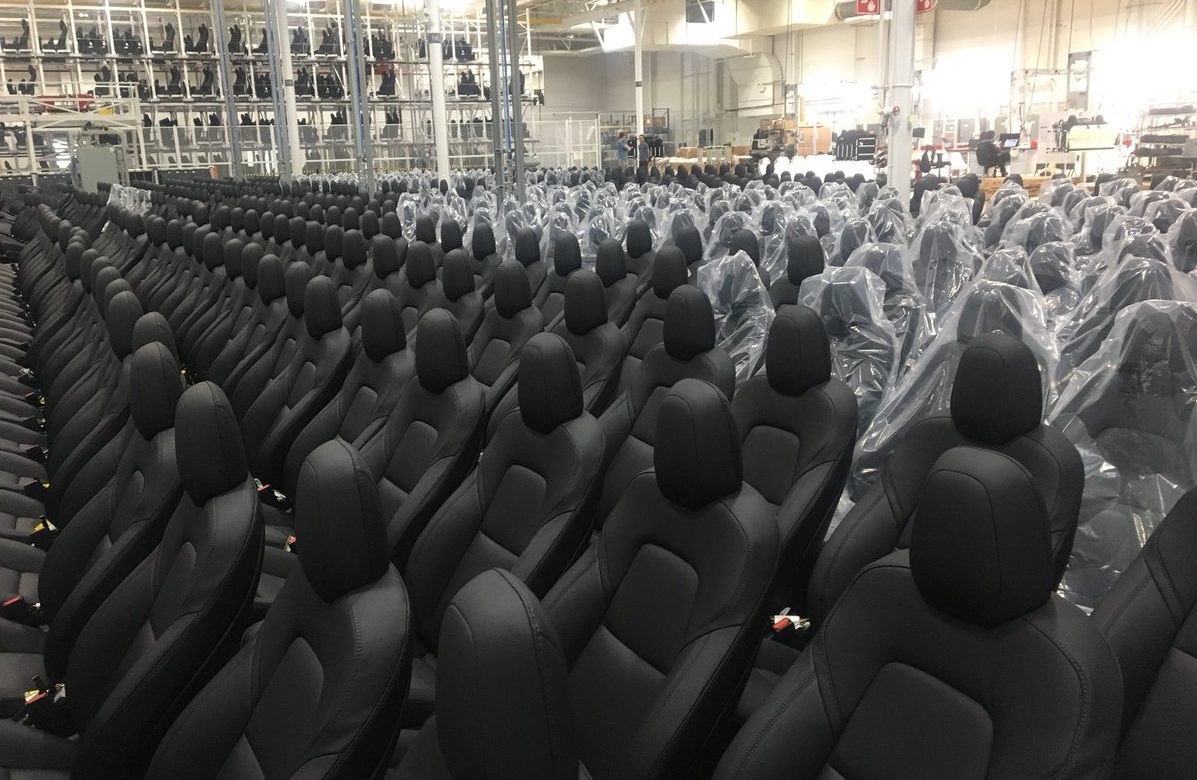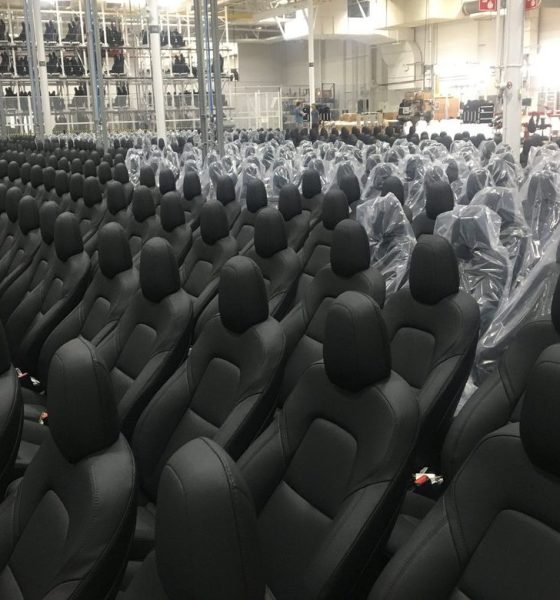

News
Elon Musk shares first look at Tesla Model 3 white seats at factory
Elon Musk recently shared an image of Tesla’s Model 3 seats in volume, showcasing rows upon rows and floors upon floors filled with the compact electric car’s seats. Musk’s Twitter upload, which included a fun Rick & Morty reference due to the seats looking almost like an alien army, also features a rare look into the Model 3 Performance’s white seats at the factory.
What is my purpose? Sentient seats. pic.twitter.com/s9aHHyDoud
— Elon Musk (@elonmusk) June 23, 2018
Musk’s Twitter update came late Friday, as Musk prepared to spend the weekend traveling back and forth between the Fremont factory and Gigafactory 1. Musk jested on Twitter that he was playing Infinity Work, the Reality Game all weekend, before revealing that he would spend Saturday and Sunday working. Musk mentioned, however, that the recently-constructed GA4 line in the sprung structure at the Fremont factory’s grounds is doing great, but Tesla’s GA3 crew, tasked with the production of the Model 3, is “pulling off miracles against all odds.”
Particularly notable in Elon Musk’s recent Model 3 seats update is the confirmation that the company is starting to build more of the Model 3 Performance Dual Motor. Earlier this month, Musk posted an image of the first Model 3 Performance rolling off the company’s new assembly line. Considering that there are several rows of white seats featured in Musk’s recent tweet, it appears that the production of the top-tier variant of the compact electric car is ongoing. White seats, after all, are exclusive to the Model 3 Performance, at least for now.
The Model 3’s white seats have been a point of interest for many Tesla owners, considering that the option has proved popular for both the Model S and Model X, thanks to their clean, unique look, as well as their surprising capability to resist stains. In announcements earlier this year, however, Musk noted that white seats for the Model 3 would likely begin production in July, together with the start of the Performance and Dual Motor AWD’s production. Tesla appears to have hit two birds with one stone with GA4, however, as the company was able to start manufacturing both the Model 3 Performance and the white seats option ahead of their expected rollout date.
Apart from rows of Model 3 seats, Elon Musk also shared an image of the Fremont factory’s paint room for the compact electric car. With his trademark humor, Musk jested that the room looks very “sus” (short for suspicious) considering its red splattered windows. Musk also shared a brief video clip of the Model 3’s assembly line, featuring what the CEO called “vicious torque” from the machines building the compact electric cars.
Looks so sus when we paint cars red pic.twitter.com/SIO2nInjhJ
— Elon Musk (@elonmusk) June 23, 2018
Tesla factory rn pic.twitter.com/EbgRDhRZ0m
— Elon Musk (@elonmusk) June 23, 2018
Tesla manufactures its seats at a facility on 901 Page Ave., roughly three miles away from the Fremont factory at 45500 Fremont Blvd. During the company’s Q4 2017 earnings call last February, Musk mentioned that Tesla is looking to incorporate technology from The Boring Company to transport seats between Page Ave. and the main factory. During the earnings call, CTO JB Straubel noted that while Tesla is developing high-density and high-velocity lines for both factories, limitations emerge when it comes to transporting the seats from one facility to another. To solve this, Musk noted that Tesla is looking to build a tunnel that connects the two factories, which would allow the company to transport seats to Fremont without relying on conventional methods.

Elon Musk
Elon Musk and Tesla AI Director share insights after empty driver seat Robotaxi rides
The executives’ unoccupied tests hint at the rapid progress of Tesla’s unsupervised Robotaxi efforts.

Tesla CEO Elon Musk and AI Director Ashok Elluswamy celebrated Christmas Eve by sharing personal experiences with Robotaxi vehicles that had no safety monitor or occupant in the driver’s seat. Musk described the system’s “perfect driving” around Austin, while Elluswamy posted video from the back seat, calling it “an amazing experience.”
The executives’ unoccupied tests hint at the rapid progress of Tesla’s unsupervised Robotaxi efforts.
Elon and Ashok’s firsthand Robotaxi insights
Prior to Musk and the Tesla AI Director’s posts, sightings of unmanned Teslas navigating public roads were widely shared on social media. One such vehicle was spotted in Austin, Texas, which Elon Musk acknowleged by stating that “Testing is underway with no occupants in the car.”
Based on his Christmas Eve post, Musk seemed to have tested an unmanned Tesla himself. “A Tesla with no safety monitor in the car and me sitting in the passenger seat took me all around Austin on Sunday with perfect driving,” Musk wrote in his post.
Elluswamy responded with a 2-minute video showing himself in the rear of an unmanned Tesla. The video featured the vehicle’s empty front seats, as well as its smooth handling through real-world traffic. He captioned his video with the words, “It’s an amazing experience!”
Towards Unsupervised operations
During an xAI Hackathon earlier this month, Elon Musk mentioned that Tesla owed be removing Safety Monitors from its Robotaxis in Austin in just three weeks. “Unsupervised is pretty much solved at this point. So there will be Tesla Robotaxis operating in Austin with no one in them. Not even anyone in the passenger seat in about three weeks,” he said. Musk echoed similar estimates at the 2025 Annual Shareholder Meeting and the Q3 2025 earnings call.
Considering the insights that were posted Musk and Elluswamy, it does appear that Tesla is working hard towards operating its Robotaxis with no safety monitors. This is quite impressive considering that the service was launched just earlier this year.
Elon Musk
Starlink passes 9 million active customers just weeks after hitting 8 million
The milestone highlights the accelerating growth of Starlink, which has now been adding over 20,000 new users per day.

SpaceX’s Starlink satellite internet service has continued its rapid global expansion, surpassing 9 million active customers just weeks after crossing the 8 million mark.
The milestone highlights the accelerating growth of Starlink, which has now been adding over 20,000 new users per day.
9 million customers
In a post on X, SpaceX stated that Starlink now serves over 9 million active users across 155 countries, territories, and markets. The company reached 8 million customers in early November, meaning it added roughly 1 million subscribers in under seven weeks, or about 21,275 new users on average per day.
“Starlink is connecting more than 9M active customers with high-speed internet across 155 countries, territories, and many other markets,” Starlink wrote in a post on its official X account. SpaceX President Gwynne Shotwell also celebrated the milestone on X. “A huge thank you to all of our customers and congrats to the Starlink team for such an incredible product,” she wrote.
That growth rate reflects both rising demand for broadband in underserved regions and Starlink’s expanding satellite constellation, which now includes more than 9,000 low-Earth-orbit satellites designed to deliver high-speed, low-latency internet worldwide.
Starlink’s momentum
Starlink’s momentum has been building up. SpaceX reported 4.6 million Starlink customers in December 2024, followed by 7 million by August 2025, and 8 million customers in November. Independent data also suggests Starlink usage is rising sharply, with Cloudflare reporting that global web traffic from Starlink users more than doubled in 2025, as noted in an Insider report.
Starlink’s momentum is increasingly tied to SpaceX’s broader financial outlook. Elon Musk has said the satellite network is “by far” the company’s largest revenue driver, and reports suggest SpaceX may be positioning itself for an initial public offering as soon as next year, with valuations estimated as high as $1.5 trillion. Musk has also suggested in the past that Starlink could have its own IPO in the future.
News
NVIDIA Director of Robotics: Tesla FSD v14 is the first AI to pass the “Physical Turing Test”
After testing FSD v14, Fan stated that his experience with FSD felt magical at first, but it soon started to feel like a routine.

NVIDIA Director of Robotics Jim Fan has praised Tesla’s Full Self-Driving (Supervised) v14 as the first AI to pass what he described as a “Physical Turing Test.”
After testing FSD v14, Fan stated that his experience with FSD felt magical at first, but it soon started to feel like a routine. And just like smartphones today, removing it now would “actively hurt.”
Jim Fan’s hands-on FSD v14 impressions
Fan, a leading researcher in embodied AI who is currently solving Physical AI at NVIDIA and spearheading the company’s Project GR00T initiative, noted that he actually was late to the Tesla game. He was, however, one of the first to try out FSD v14.
“I was very late to own a Tesla but among the earliest to try out FSD v14. It’s perhaps the first time I experience an AI that passes the Physical Turing Test: after a long day at work, you press a button, lay back, and couldn’t tell if a neural net or a human drove you home,” Fan wrote in a post on X.
Fan added: “Despite knowing exactly how robot learning works, I still find it magical watching the steering wheel turn by itself. First it feels surreal, next it becomes routine. Then, like the smartphone, taking it away actively hurts. This is how humanity gets rewired and glued to god-like technologies.”
The Physical Turing Test
The original Turing Test was conceived by Alan Turing in 1950, and it was aimed at determining if a machine could exhibit behavior that is equivalent to or indistinguishable from a human. By focusing on text-based conversations, the original Turing Test set a high bar for natural language processing and machine learning.
This test has been passed by today’s large language models. However, the capability to converse in a humanlike manner is a completely different challenge from performing real-world problem-solving or physical interactions. Thus, Fan introduced the Physical Turing Test, which challenges AI systems to demonstrate intelligence through physical actions.
Based on Fan’s comments, Tesla has demonstrated these intelligent physical actions with FSD v14. Elon Musk agreed with the NVIDIA executive, stating in a post on X that with FSD v14, “you can sense the sentience maturing.” Musk also praised Tesla AI, calling it the best “real-world AI” today.








